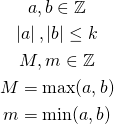This is the fifth part of the ILP series. For your convenience you can find other parts in the table of contents in Part 1 – Boolean algebra
Last time we defined formulas to compare values. Today we are going to use them to calculate absolute value, maximum, and minimum functions.
Table of Contents
Absolute value
We will start with absolute value. Just like in previous part, we need to know the maximum possible value of a variable denoted as ![]() .
.
Variables
We want to use the following variables:

Basically, we have one variable called ![]() . We don’t know whether this variable is positive or negative. We also want to declare variable
. We don’t know whether this variable is positive or negative. We also want to declare variable ![]() which will be equal to absolute value of
which will be equal to absolute value of ![]() . So for non-negative
. So for non-negative ![]() it will be equal to
it will be equal to ![]() , however, for negative
, however, for negative ![]() it will have its value negated.
it will have its value negated.
Intuition and final formula
We will start with two simple constraints. We want ![]() to be absolute value of
to be absolute value of ![]() , so we know for sure that
, so we know for sure that ![]() must be:
must be:
![]()
This can be interpreted as: “![]() must be on the right side of
must be on the right side of ![]() on the number line. However, this is not enough because
on the number line. However, this is not enough because ![]() might not be equal to
might not be equal to ![]() .
.
Now we can use geometric interpretation of absolute value of a number. It is a number’s distance from origin. We want ![]() to have the same distance and to achieve this we need to add the following constraints:
to have the same distance and to achieve this we need to add the following constraints:
![]()
This line basically says: either the sum of ![]() and
and ![]() is zero or the sum of negated
is zero or the sum of negated ![]() and
and ![]() is zero. Here we use relational operators defined in previous part and this is the place where we need to know the upper bound of
is zero. Here we use relational operators defined in previous part and this is the place where we need to know the upper bound of ![]() ‘s value.
‘s value.
Maximum, minimum
Using similar intuition we can define maximum and minimum functions. We start with the following variables:

First, we want ![]() to be “on the right side” of
to be “on the right side” of ![]() and
and ![]() :
:
![]()
Similarly, we want ![]() to be “on the left side”:
to be “on the left side”:
![]()
And now the final piece: we want the distance between ![]() and
and ![]() to be the equal to the distance between
to be the equal to the distance between ![]() and
and ![]() :
:
![]()
We need to use the absolute value only on the left side because we know that ![]() .
.
However, this will not work. In previous part we defined and used ![]() and we showed why it is important to define it this way. However, our absolute value function uses relational operators, and these assume that their arguments are not greater than
and we showed why it is important to define it this way. However, our absolute value function uses relational operators, and these assume that their arguments are not greater than ![]() . But for
. But for ![]() and
and ![]() we break this constraint. There are two possible solutions:
we break this constraint. There are two possible solutions:
Solution 1
We can change the definition of ![]() to
to ![]() . This will work but it has one drawback: imagine that our solver is able to perform calculations on 32-bit integers. Because we need to be able to represent
. This will work but it has one drawback: imagine that our solver is able to perform calculations on 32-bit integers. Because we need to be able to represent ![]() using 32 bits, we are effectively reducing the size of the rest of our variables. This might be painful.
using 32 bits, we are effectively reducing the size of the rest of our variables. This might be painful.
Solution 2
We might want to change the last constraint to:
![]()
In theory, this should work. However, imagine the situation when ![]() is odd. We need to represent the result of division using floating point values and this might cause some problems with representation errors with more sophisticated calculations. However, using this approach we do not reduce the size of our variables as with the previous solution.
is odd. We need to represent the result of division using floating point values and this might cause some problems with representation errors with more sophisticated calculations. However, using this approach we do not reduce the size of our variables as with the previous solution.
Summary
We have defined three useful functions. In next parts we will see that they might look trivial, but they are really powerful and we will use them to define much more complicated calculations. See you next time.